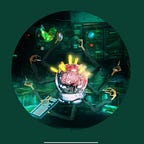Mosaic Powering Cross-Layer NFT Swaps
Composable Labs introduces another essential cross-layer functionality under its development: the swapping of non-fungible tokens across different L2s, powered by Mosaic.
Non-fungible tokens (NFTs) are emerging as a popular and powerful tool in decentralized finance and beyond. However, while their uniqueness is a large driver beyond this growing use, it is also what makes cross-layer transferrals so difficult for NFTs. Thus, Composable Labs is releasing its newest project, the cross-layer 2 transferral of NFTs optimized by Mosaic.
NFTs’ individuality has proven prohibitive for cross-layer 2 transfers.
NFTs utilize the ERC-721 token standard making them unique and capable of having different values, representations, and identifying numbers than other tokens from the same smart contract basis. This imparts their non-fungibility, meaning they are not interchangeable with each other. While this makes them uniquely well suited for a number of applications such as representing digital artworks, boosts, or receipts, it makes cross-layer transferrals difficult. By definition, there must only be one instance of each NFT, and thus they cannot be represented on multiple layers at a time.
However, these cross-layer transferrals are becoming increasingly important for NFTs (and all other tokens). The L2 revolution is clearly upon us, and NFTs are gaining in popularity.
Composable Labs is facilitating these cross-layer NFT swaps utilizing Mosaic.
Composable Labs recently announced Mosaic, which will create an optimized method of LPing for and fulfilling cross-layer transfers. Leveraging Composable’s cross-layer tech stack, Composable Labs has devised a method for maintaining the essential, non-fungible characteristics of NFTs, while also enabling cross-layer utility of these tokens.
We will be utilizing Mosaic to lock the original NFT in one location (the layer it is on) and creating a single representation of the NFT on another location (another L2). There will be two different contract addresses, but the same jpeg for the NFT. This new version of the NFT can also be locked to unlock another version on another L2, and so on. Therefore, there is only one unlocked version of the NFT at a time, meaning it still retains non-fungibility while being able to move across different locations.
Within this process, a relayer will receive an oracle update showing that the NFT has been locked on L2 and can immediately submit a transaction on L1 or another L2 to release. The benefit of this design is that it can sidestep the delay period for a fraud proof or similar mechanism.
There are many important use cases for swapping NFTs across layer.
NFTs are growing in popularity at an exponential rate, and there is demand for them across the vast number of layer 2 solutions in DeFi. The broad use case of our platform would be moving a user’s NFT to another layer, for storage or use there. For example, our Proof of Concept (PoC) of Mosaic currently consists of the Polygon-Arbitrum Cross-Layer Transferral System connecting these two L2s to each other and the Ethereum mainnet. Users will now be able to move their NFTs along this PoC.
Within this, there are many specific utilities users can carry out. For instance, a user may mint an NFT from a platform on Arbitrum, that represents a digital piece of art. Then, the user can move this NFT to Polygon to sell on the NFT marketplace OpenSea.
Through these cross-L2 NFT transfers, we aim to fulfill an important yet unmet need in the DeFi space, particularly as NFTs continue to rise in popularity, and Mosaic will play an important role in that process. Stay tuned for more updates as we work to build out this solution.
If you are a developer with a project you think fits our ecosystem and goals, and you would like to participate in our interactive testing landscape at Composable Labs, reach out to me on Telegram at @brainjar.
